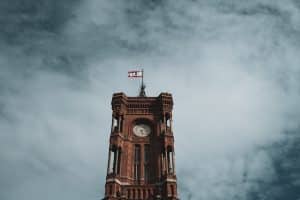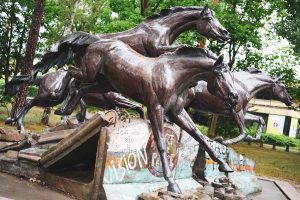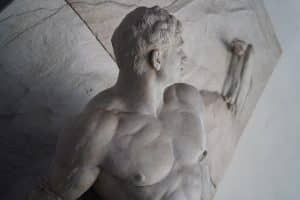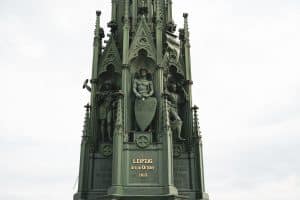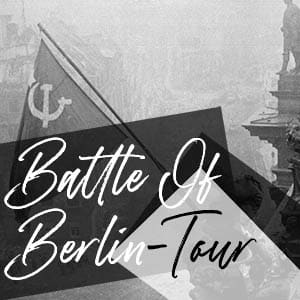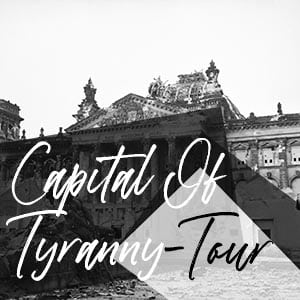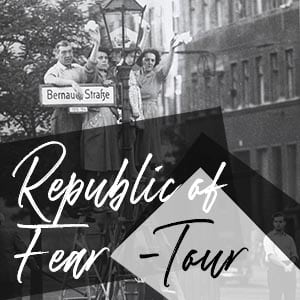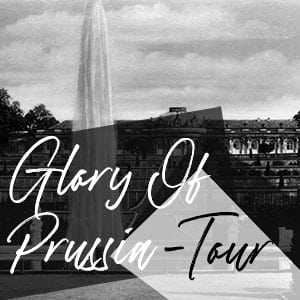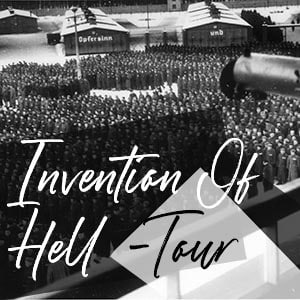Although nowhere near as large as Moscow, Tokyo, or New York – Berlin is still substantial enough in size to seem somewhat threatening to a new arrival.
As the current capital of Germany, the city developed into a booming metropolis in the early 1900s – considered, in-fact, the third largest city in the world at that time (it should hardly come as a surprise to learn that Berlin now is not even in the top 300).
Undeniably, the city’s historically significant landmarks are of world import – often recognisable from their silhouettes alone. Although Berlin’s streets, spacious and giving, may not have developed like the donkey-paths of Rome or London, they hold just as many secrets – often hiding in plain sight.
And while the guidebook format exploration of the German capital demands the obligatory visits to the Brandenburg Gate, Checkpoint Charlie, and the Wall – in this article we will be looking at a different side of the city.
Via the quirky, the unusual, and the obscure.
Berlin's Most Unusual Objects
Scattered across the German capital are a wealth of objects that add further colour to the story of the city. Some are present in museums (items we have chosen for their strange significance) while others require a little more vigilance and dedication to discover – literally being off-the-beaten path.
Read on to experience Berlin through its wackiest, weirdest, and possibly most interesting objects… the oldest tree in Berlin, the tallest free standing aquarium in the world, a secret graffiti street-code that rates art galleries, possibly the weirdest clock in the world – and much more…
–

01 | The Flächenschwerpunkt
Berlin is a city of many centres; but only one – the geographical centre – has its own polished granite tablet telling you exactly where you are. Ground zero – tucked away in a small park in the city district of Kreuzberg. This was first calculated in 1990, and reconfirmed in 1994 and 1997 – with the coordinates 52°30’10″N /13°24’15″E.
Other contenders for the title of ‘centre of Berlin’ have been considered as the city has changed and in 2010 the former head of the Potsdam planetarium proposed that the exact centre of Berlin is now in the district of Neukölln – in front of the house on the Spremberger Straße 4.
Although there is no plaque there, so does it really count?
–
Address: Alexandrinenstraße 12, 10969 Berlin
Website: None

02 | The Numbered Trees
The Berlin government’s act of counting and numbering the city’s tree population certainly does little to counter the pervasive German stereotype of pedantic behaviour and tendency to indulge in unnecessary bureaucracy. Around one third of Berlin is made up of parkland and greenery – with more than 430,000 counted trees.
Make sure to check the tree trunks as you pass by – and you’ll notice little blue or white signs featuring a number. Although these do little to explain anything about the trees, there area over fifty different species lining Berlin’s streets, with the five most common being linden, maple, oak, plane and chestnut.
–
Address: Various Locations
Website: The Berlin government site
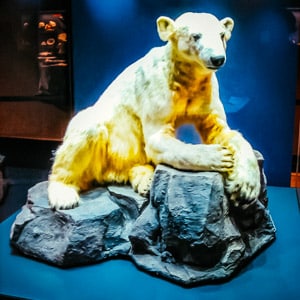
03 | Knut The Polar Bear
The other Berlin bear, Knut was previously the star attraction at the West Berlin zoo, until his tragic death in 2011. Rejected by his mother at birth, he was raised by his zookeepers – only to experience the distress of losing his long-term carer to a heart attack in 2008. Knut lived for another three years and was considered solely responsible for a massive increase in revenue as the media hyped ‘Knutfever’ and zoo entrance numbers soared. After registering ‘Knut’ as a trademark, the Zoo saw its shares double in value on the stock market.
The famous polar bear can now be found on display at the Natural History Museum, surrounded by other celebrity animals.
–
Address: Invalidenstraße 43, 10115 Berlin
Website: Museum für Naturkunde

04 | The Dicke Marie
Berlin’s oldest tree, the Dicke Marie (Fat Marie), is speculated to even predate the establishment of Berlin – and likely first started taking root all the way back in the 1100s. Situated in the district of Tegel, this English Oak was in-fact named by the famous Humboldt brothers – after their cook. It can be found a short distance from Schloss Tegel (where the brothers lived).
It has been speculated that the tree may only be around 400 years old, due to its circumference of 6 metres – as oak trees older than 800 years usually reach at least 8 metres. The core of the tree has sadly rotten away, so calculating the exact age using the trees annual rings is no longer possible.
–
Address: An der Malche 1, 13507 Berlin
Website: None
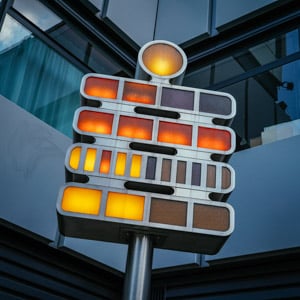
05 | The Mengenlehreuhr
If you’re looking for the weirdest clock in Berlin – this is it. At first glance, what may appear to look more like a futuristic traffic light, is actually the first public clock in the world that registers time by means of illuminated, coloured fields. Not only does the Mengenlehreuhr feature in the Guiness Book of World Records for this achievement, but also a famous, and so far unsolved, CIA cryptology puzzle. Read from top to bottom the rows of lights represent five hours, one hour, five minutes, and one minute.
Previously located on West Berlin’s famous Ku’damm shopping street, the clock was moved to its current location – outside the Europa Center, opposite the Zoo – in 1995.
–
Address: Budapester Strasse 5, 10787 Berlin
Website: None
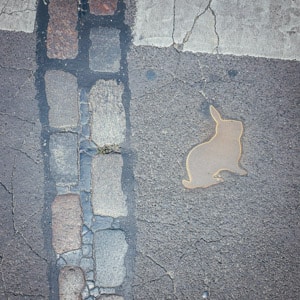
06 | The Berlin Wall Rabbits
Due to the lack of human activity in the ‘Death Strip’ area of the Berlin Wall, many different species of wild animal would come to call this isolated zone home – in particular, wild rabbits. While East German border guards would initially take pot shots at the little bunnies, in an attempt to control the population, the government would eventually prohibit this practice – else anyone assume the sound of gunfire was indication that the guards were in-fact shooting at people.
When the Wall fell in 1989, these rabbits lost their habitat and were left to roam the city – their brief foray into mass urban living commemorated by this installation to be found on Chausseestrasse.
–
Address: Chausseestraße, 10115 Berlin
Website: None
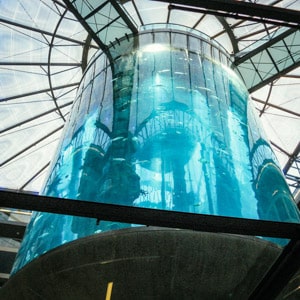
07 | The Tallest Aquarium
Housed in the lobby of the Radisson Blu is the largest acrylic cylindrical aquarium in the world – 82 feet in height, this monster is home to around 1,500 fish, floating around in about 1 million litres of water. It is now the main attraction of the Berlin Sea Life Centre, where for a hefty sum you can pay to ride the internal elevator up through the aquarium for an unusual view of this unusual attraction.
If you get there are the right time you can also either see the diver inside cleaning the tank or the feeding of the fish – unfortunately being a guest at the hotel no longer grants you the possiblity to ride in the elevator to your room.
–
Address: Karl-Liebknecht-Strasse 3, 10178 Berlin
Website: Sealife Center Berlin

08 | The Art Banana
Cologne artist Thomas Baumgärtel (aka the Banana Sprayer) has developed been spray painting bananas onto art venues and museums as a sign of approval and seal of quality since 1986. With around 4,000 cultural institutions worldwide inducted into his exclusive club, Baumgärtel has managed to elevate his Dadaist street action into an internationally recognised icon of the art scene.
This instance can be found on the Sammlung Boros gallery, a former Nazi-era air raid shelter converted into an art gallery in the 1990s – although fittingly it also served during the East German times as a storage facility for exotic fruits – including bananas!
–
Address: Various Locations
Website: The Banana Sprayer
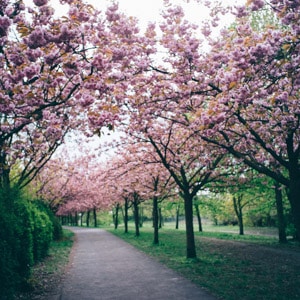
09 | Japanese Cherry Trees
By following the Berlin Wall trail (the Berliner Mauerweg) it is now possible to walk, or bicycle, along the entire 160km of the former Berlin Wall and ‘death strip’. Visit in early spring and you’ll have the opportunity to see these beautiful cherry blossoms, planted at numerous locations along the Mauerweg in the 1990s following the so-called Sakura Campaign led by a Japanese television network (TV Asahi).
Around 140 million yen (1€ million) was raised in donations from around 20,000 people and paid for 9,000 trees. The first were planted next to the Glienicke Brücke (the Bridge of Spies) although this avenue next to the Bösebrücke is perhaps the most famous location.
–
Address: Norwegerstraße, 10439 Berlin
Website: None
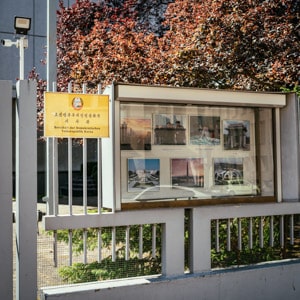
10 | North Korean Propaganda
Few countries maintain diplomatic ties with the Peoples Democratic Republic of Korea (North Korea). Berlin’s North Korean embassy dates back to the East German time, as the current building was constructed in 1975 on the site of the former Hotel Kaiserhof (Adolf Hitler’s unofficial residence as his rose to power in 1933).
The embassy entrance boasts this cheery streetside display of party propaganda, depicting the great achievements of the North Korean state and Great Leader Kim Jong Un. The adjacent City Hostel, finally closed in 2020 after a protracted battle to stop North Korea making money from rent, in violation of UN resolution 2321.
–
Address: Glinkastraße 5-7, 10117 Berlin
Website: None

11 | The Bierpinsel
Like many buildings constructed in the 1970s, this odd structure has a distinctly futuristic feel. Designed by the same architects responsible for the monstrous Berlin Convention Centre, the Bierpinsel (Beer Brush) was originally opened as a restaurant – and housed one of Germany’s first salad bars – although has since been plagued by funding and tenancy issues.
A rare inclusion of a building on our list of objects, the Bierpinsel arguably qualifies as it is not only an iconic testament to the hideously attractive aspirations of pop-architecture in the 1970s but has probably spent as much time empty as it has occupied.
–
Address: Schloßstraße 17, 12163 Berlin
Website: None

12 | The Molecule Man
These three 30-metre high aluminium figures on the river Spree have no doubt confused plenty of visitors to the city. Created by American artist, Jonathan Borofsky, this 45 tonne art work is actually positioned to illustrate the intersection of three Berlin neighbourhoods – Kreuzberg to the south, Friedrichshain to the north, and Treptow to the east – the holes represent “the molecules of all human beings coming together to create our existence.”
Borofsky has other Molecule Men elsewhere, although this is the largest – with the figures actually modelled from a Sports Illustrated photo depicting two college basketball players congratulating each other, having won the NIT basketball tournament.
–
Address: An den Treptowers 1, 12435 Berlin
Website: The Berlin Government site
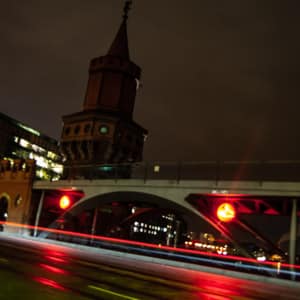
13 | The Rock Paper Scissors
Constructed as a tax bridge spanning the river Spree, the Oberbaumbrücke now connects the neighbourhoods of Friedrichshain and Kreuzberg. It would see use as a border crossing during the Cold War period, until the ‘Fall of the Wall’ in 1989. One of the iconic landmarks in this area of the city, it often serves as the further point east on the river for tour boat trips.
Come here at night and you’ll find this illuminated art piece installed on the train bridge – where it is possible to play rock-paper-scissors. If you’re feeling really brave, swing by in the summer, when residents organise an annual food fight pitching Kreuzberg against Friedrichshain.
–
Address: Oberbaumbrücke, 10243 Berlin
Website: None
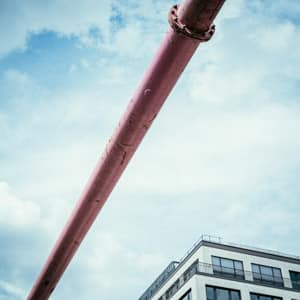
14 | The Pink Pipes
More than merely a matter of adding a dash of colour to the otherwise restrained pastel-based palette of Berlin’s cityscape – these pink tubes actually serve as overground waste removal pipes – to the horror of many visitors. Temporarily installed across the city to deal with Berlin’s high water table and the swampy ground that makes construction work more hazardous.
For more than a century a company called Pollems has been responsible for the introduction and maintainance of these colourful pipes: choosing the colour pink after consulting a psychologist and being told that it is soothing and inoffensive – and that it would also be popular with children.
–
Address: Various Locations
Website: None
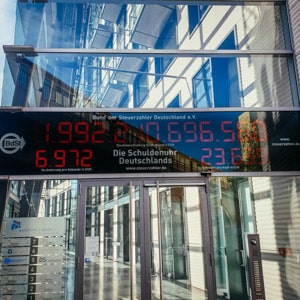
15 | The Debt Clock
As Europe’s biggest economy, Germany has managed to burden its tax payers with a considerable amount of debt. In an attempt to raise awareness of this lack of fiscal responsibility, the German Taxpayers Federation installed a Debt Clock outside their headquarters in 2013 to highlight the misuse of public funds and promote the reining in of government spending.
The clock continues to rack up the debt – although there was a time back in 2018 when it started moving in the opposite direction – at a rate of 78€ per second. Meaning that at that rate it would take only 800 years to pay back the 2€ trillion worth of federal and state debt.
–
Address: Reinhardtstraße 48-52, 10117 Berlin
Website: Bund der Steuerzahler e.V.

16 | The Orange Bins
Although in many German cities – and train stations – it is common to find segregated rubbish bins for recycling paper, packaging, and compostable waste, the Berlin litter bins are easy to spot due to their bright orange colour and comical slogans. Even though Berlin is a city of smokers, it seems few people realise these bins also have ashtrays.
Due to the country’s bottle recycling policy, you might see people reaching into the bins looking for empty containers. Feel free to leave your bottles underneath these orange bins to save them the dirty task- or you can return your own empties to a supermarket and expect to be rewarded with up to 25 cents per bottle.
–
Address: Various Locations
Website: None
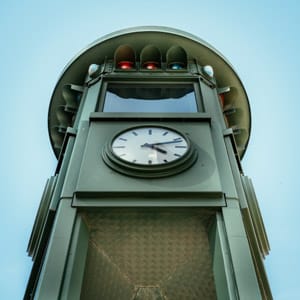
17 | The Potsdamer Platz Lights
Potsdamer Platz’s reputation as the Times Square or Picadilly Circus of Berlin is largely due to the immense amount of traffic that this junction attracted at its peak in the 1920s and 30s. It came to be regarded by many as the busiest intersection in Europe: ripe for the addition of this famous five sided traffic light tower – produced by Siemens & Halske.
Installed in 1924, they were initially operated by a solitary policeman who would sit inside the cabin, until in 1926 the tower was upgraded to become the first automatically operated traffic light system in Europe. The version that currently stands at Potsdamer Platz, however, is a replica added in 1997.
–
Address: Potsdamer Platz 11, 10785 Berlin
Website: Potsdamer Platz Website
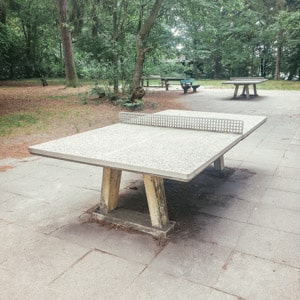
18 | The Table Tennis Table
Believe it or not, Berlin is widely considered the capital of hobby table tennis. If in doubt, try visiting any of the recreational areas dotted across the city. You’ll find the city is full of these sturdy concrete tables – more than 1000 of them – often covered in graffiti and bird poop, where it is not uncommon to see Berliners swatting at a ball and swigging cheap beer in the summer sun.
This kind of recreation was particularly popular in what was East Berlin – perhaps due to the low cost investment needed to attain maximum fun – whereby once you have acquired the necessary tools (bats and ball), all you need is to find an empty table.
–
Address: Various Locations
Website: The Ping Pong Map
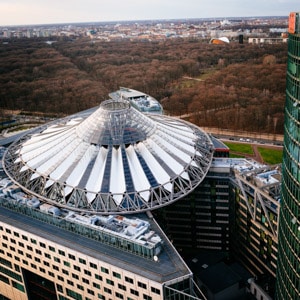
19 | Mount Fuji
A less than subtle nod to the homeland of the company responsible for the construction of this corner of Potsdamer Platz in the 1990s, the top of the Sony Center is capped with this huge glass and steel roof designed to resemble the summit of Mount Fuji. The area below is a plaza centred around a water feature; best experienced at night when the fan-shaped tented roof acts as the illuminated cherry on top of the whole Potsdamer Platz ensemble.
Although Mount Fuji is considered holy in Japanese culture, as the residence of the Kami (divinities) – the structure proved no lucky charm for Sony, who incurred a substantial loss when the area was sold in 2008.
–
Address: Potsdamer Straße 4, 10785 Berlin
Website: Sony Center
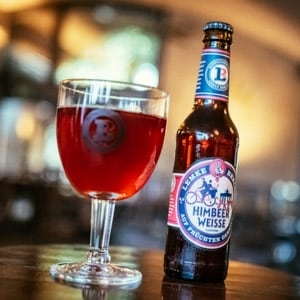
20 | The Berliner Weisse
A distinctly Berlin phenomenon, the Berliner Weissbier is said to have been referred to by Napoleon’s occupying troops in the 1800s as the ‘Champage of the North’. A top-fermented beer that is brewed with a large proportion of wheat malt, it is typically served with a syrupy shot of woodruff or raspberry.
Although some Berlin breweries, such as Brauhaus Lemke, have awardwinning naturally flavoured versions that omit the sugary shot in preference for more ‘authentic’ ingredients. Regardless of the ingredients, the short stubby glass is always the same – and if you want to indulge in true Berlin style, you’ll drink it through a small straw.
–
Address: Dircksenstraße 143, 10178 Berlin
Website: Brauhaus Lemke
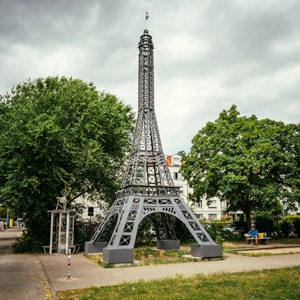
21 | The Eiffel Tower
Little remains in Berlin as evidence of the French occupation of roughly one quarter of the city (the districts of Wedding and Reinickendorf) during the Cold War period – with the major exception of Tegel Airport!
This easily identifiable faux-landmark sits outside the Centre Français de Berlin, which was inaugurated, in 1961, as a cultural centre run by the French allied forces in the city. Surprisingly the Berlin Eiffel Tower is a poor reproduction of the original – with the intersection of the four pillars on the second floor being inaccurate – truly a poor representation of one of France’s great cultural icons on the site of the French cultural exchange.
–
Address: Müllerstraße 74, 13349 Berlin
Website: Centre Français de Berlin
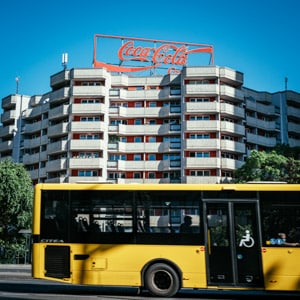
22 | The Coca Cola Plattenbau
These towering prefabricated Plattenbau apartment blocks – peak Socialist housing – can still be found dotted across the eastern part of Berlin. Concrete monuments to central planning – with their distinctly drab East German flair. Although previously highly desirable in East Germany, these residential blocks have fallen out of favour with many Berliners.
Above the Spittelmarkt train station, along the busy Leipzigerstrasse thoroughfare, you can find a prime example of this type of architecture, now fittingly topped with a huge Coca Cola sign – fusing the cliches of capitalism and communism in one location. Pure ideology.
–
Address: Seydelstraße 37, 10117 Berlin
Website: None
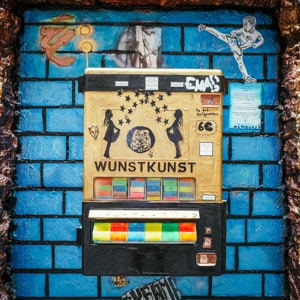
23 | The Art Automat
There is no shortage of art in Berlin, whether it be in galleries or on the streets – thanks to the kind of people the city attracts, and the notoriously cheap rents over the last 30 years (even if that has now changed).
This funky Art Automat (Wunst Kunst) can be found in a courtyard near the Hackescher Markt, dispensing original works in exchange for a small handful of coins. Although seemingly unique, this concept has proven so popular that there are now a number of different versions of the art automat dotted across the city. This box is tucked away in a small passageway leading to the Otto Weidt Workshop museum, and the Haus Schwarzberg.
–
Address: Rosenthaler Strasse 39, 10178 Berlin
Website: Wunstkunst
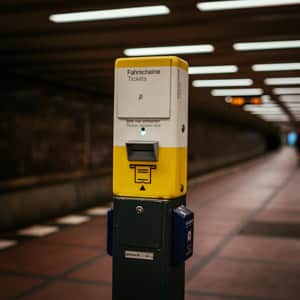
24 | The Train Ticket Machine
Berlin’s extensive transportation network is the second largest is Europe (behind London) – and not only is it relatively fun to ride but also relatively straightforward. Purchasing a ticket is a simple as navigating through the touchscreen displays to be found at each station (also available in English) and acquiring your paper ticket from the dispenser at the bottom.
However, don’t forget to feed the ticket into one of these validation machines before you board the train – as an unvalidated ticket can earn you a 60€ fine. This only applies to train tickets, as if you buy a bus or tram ticket on board your ride it comes automatically stamped with the departure time.
–
Address: Various Locations
Website: The Berlin Transporation Site
Explore these sites and more with a private guide in Berlin via Berlin Experiences.
Our Related Private Tours
Learn more about the Battle of Berlin and explore this urban battlefield with our Battle of Berlin tours.
Learn more about the history of Nazi Germany and life in Hitler’s Third Reich with our Capital Of Tyranny tours.
Learn more about the history of East German and life behind the Iron Curtain with our Republic Of Fear tours.
Learn more about the history of Prussia and the life of Frederick the Great with our Glory Of Prussia tours.
Learn more about SS ‘Protective Custoday’ on our Sachsenhausen Concentration Camp Memorial tours.


